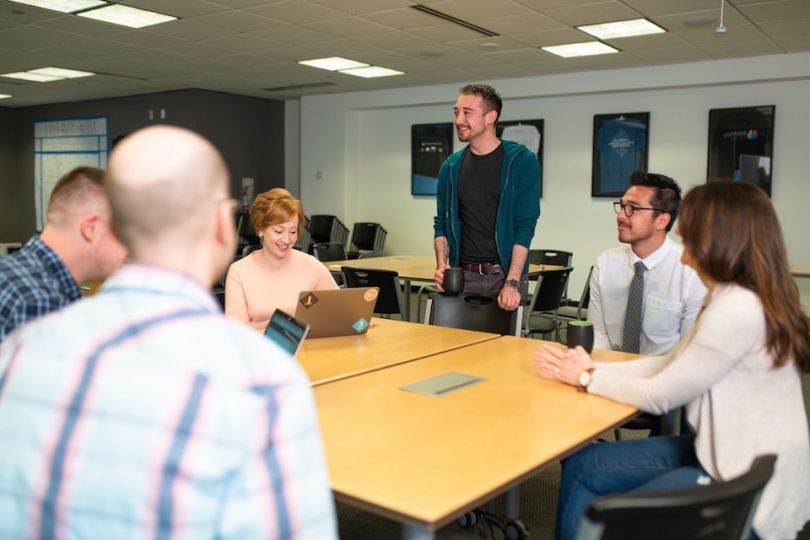An entrepreneur may have a groundbreaking idea, assemble a world-class team and find backers to fund their first few years — but the world’s not going to wait while they test and prove their theory. Tech leaders must always keep an eye on industry trends, and what their customers want.
In part two of our series on how industry leaders stay ahead of the pack, we spoke with four Seattle techies about the big changes they anticipate, and what they’re doing in response.

Cybersecurity firm eSentire uses a combination of artificial intelligence and professional expertise to protect clients from hackers. Headquartered outside Toronto, the company arrived in the Pacific Northwest with its acquisition of Versive, a machine learning-driven cybersecurity startup, last October.
CTO Dustin Rigg Hillard led the tech team at Versive, and now leads technology efforts for eSentire.
How has your company set itself apart as a leader in your industry? What tech innovations have helped you differentiate yourself?
Since our founding in 2001, we’ve been a partner that enables our customers to operate their business safely with the knowledge that we continually evolve to recognize and eliminate security threats. Many businesses are unable to hire, train, and retain the talent needed to proactively protect their business, which is why we created the Managed Detection and Response (MDR) category.
To protect our customers, we use machine learning to automate the blocking of known threats; combine machine learning with human expertise to discover and neutralize unknown attacks, persistent threats, and insider threats; and continue to providing access to elite experts and advisors to answer questions and help organizations assess their security strengths and weaknesses.
‘Buzzword bingo’ is a game that we are all tired of playing, but it is predominant in cybersecurity.”
What do you think will be the next big tech trend in your industry? How do you plan to stay ahead of that trend?
“Buzzword bingo” is a game that we are all tired of playing, but it is predominant in cybersecurity. If we cut through the noise, we can all agree that machine-scale problems require machine-scale solutions. When applied in the right way, machine learning can augment the analyst, not replace them. We focus on building the technology that solves customer problems at scale, not just to make sexy marketing claims. We are building technology that doesn’t exist anywhere else, but we prefer to talk about how that results in security outcomes our customers can’t get anywhere else.

Through an all-in-one dashboard connected with multiple social media platforms, Sprout Social makes brand management and engagement strategies that much easier. The company also produces analytics and advocacy solutions for clients in a vast array of industries.
Lead Product Manager Jeremy Wemple said he’s closely examining the workflows of Sprout customers, and learning how to optimize their experiences within the platform.
How has your company set itself apart as a leader in your industry? What tech innovations have helped you differentiate yourself?
Establishing ourselves as a leader in the market means continually delivering exceptional experiences to our customers. We do this by refusing to sacrifice simplicity in the product’s functionality, which we achieve by developing a deep understanding of what our users hope to accomplish — and how they do that within Sprout. This ongoing learning process is strengthened by our partnerships with all of the major social media platforms. By getting feedback from both our customers and industry titans in the space, we are eliminating the guesswork that many other companies face in understanding where the market and platforms themselves are heading.
In regards to innovations that have fueled our differentiation, changing our offering from a single solution management platform to a robust suite of tools is one of the most important. Instead of switching between separate tools to accomplish one task, Sprout users can complete all their social management, publishing, reporting and analytics needs within one streamlined platform.
Instead of offering these solutions as individual products, we expect to see them delivered as a bundle.”
What do you think will be the next big tech trend in your industry? How do you plan to stay ahead of that trend?
Right now, the social media market focuses on tools that are divided and stand alone. Instead of offering these solutions as individual products, we expect to see them delivered as a bundle — providing a “one-stop-shop” service to streamline workflows.
Our tools need to work with one another so that our customers can spend more time on their core responsibilities. We plan to deliver on this vision by focusing on our customers’ workflows and allowing them to seamlessly complete their job without needing to jump between fundamental sections of our app.

Suplari’s artificial intelligence algorithms sift through a business’ financial data to help find ways to cut costs. The platform surfaces issues that may require further investigation, and sits on top of existing enterprise systems without the need for extensive consultations. Headquartered in downtown Seattle, Suplari recently ranked on Built In Seattle’s 50 Startups to Watch in 2019.
Chief Product Officer Brian White says his company is helping finance and procurement teams put their shoulders to the wheel in navigating an era of technological disruption.
How has your company set itself apart as a leader in your industry? What tech innovations have helped you differentiate yourself?
Setting yourself apart in tech innovation in Seattle is no small feat, but we realized there was a chance to disrupt how finance and procurement teams use the information locked in their ERPs to directly impact business results. As serial entrepreneurs, we've seen big disruptions like the internet and cloud computing, and with the accessibility of machine learning, it seemed like a natural place to jump in.
We started with a world-class, modern user experience on top of financial data, but focused our innovation on providing a platform for data engineers and data scientists to easily access financial data, as well as quickly iterate on experiments that produce results. Connecting data and data science to outcomes that produce or detect new opportunities for humans to achieve business results was our biggest differentiation.
Right now, finance and procurement teams are left on their own, and lack any true data science resources. We think that is going to change.”
What do you think will be the next big tech trend in your industry? How do you plan to stay ahead of that trend?
Right now, finance and procurement teams are left on their own, and lack any true data science resources. We think that is going to change. Our plan is to first democratize the data so that anyone at a company who spends money or owns a budget can have the best information available to them, including spend, contracts, purchase orders, supplier sentiment and so on. Secondly, we plan to deliver highly usable tools for financial analysts that include advanced algorithms — think about it as Excel Macros on steroids.
We believe we can bring these tools to finance and procurement professionals so they can be heroes to the business — not as roadblocks to progress. Suplari is able to automate a lot of the repetitive tasks that finance and procurement teams must suffer through in aggregating, cleansing and analyzing data. Now, Suplari allows finance and procurement teams to partner with the CEO and their business counters on strategic initiatives, instead of reporting. With businesses trying to stay alive in an era of disruption, it just makes sense for finance and procurement to join the fight.
Wrench uses the power of the shared economy to disrupt the automotive maintenance and repair industry. Using its app, motorists can summon a mobile mechanic who, according to Wrench, can perform 80 percent of their work outside a workshop. The Seattle startup raised $12 million last October, and is currently developing a fleet management solution.
VP of Marketing and Business Development Casey Willis said the company is looking to use technology to offer personalized service plans for users based on the type of car they drive.
How has your company set itself apart as a leader in your industry? What tech innovations have helped you differentiate yourself?
Wrench has set itself apart as a leader in the tech automotive space by offering a convenient solution to auto repair, and employing a top-notch team of full-time mechanics who are vetted, certified and trained with the customer experience in mind.
On top of that, we have also built a high tech, cutting-edge platform that allows both consumers and companies to maintain their vehicles’ health and address all of their automotive needs at their home, office or any location of their choice. Wrench offers a wide variety of services to their customers, including but not limited to vehicle inspection, full diagnostics, oil changes, mobile detailing and tire services.
We believe the service should be customized based on your lifestyle as well as your vehicle’s needs.”
What do you think will be the next big tech trend in your industry? How do you plan to stay ahead of that trend?
We believe the next big trend in the auto repair industry will be regularly scheduled maintenance within a mobile app or online platform. We plan on staying ahead of this trend by continuously improving the Wrench product as well as the customer experience.
Our team is currently working on technology that offers car-specific service plans and vehicle recommendations based on the unique driving patterns for each user since we believe the service should be customized based on your lifestyle as well as your vehicle’s needs.







